A Comprehensive Clinical Teaching Plan for Alzheimer's Disease Care
VerifiedAdded on 2023/06/12
|13
|3335
|92
Report
AI Summary
This clinical teaching plan provides a comprehensive overview of Alzheimer's disease for registered nurses, covering the introduction, signs and symptoms, diagnosis, treatment, and the nurse's role in patient care. It discusses the theories of education, including pedagogy, andragogy, and social cognitive theory, highlighting factors that enhance and impede learning sessions. The plan details the use of PowerPoint presentations and literature reviews to educate nurses about dementia, its prevalence, and risk factors. It also addresses assessment and diagnosis methods, emphasizing the importance of mental and social stimulation, and the influence of family background and genetics in Alzheimer's disease. This resource aims to improve nurses' knowledge and skills in managing patients with Alzheimer's, offering insights into effective teaching methodologies and the creation of inclusive educational models.
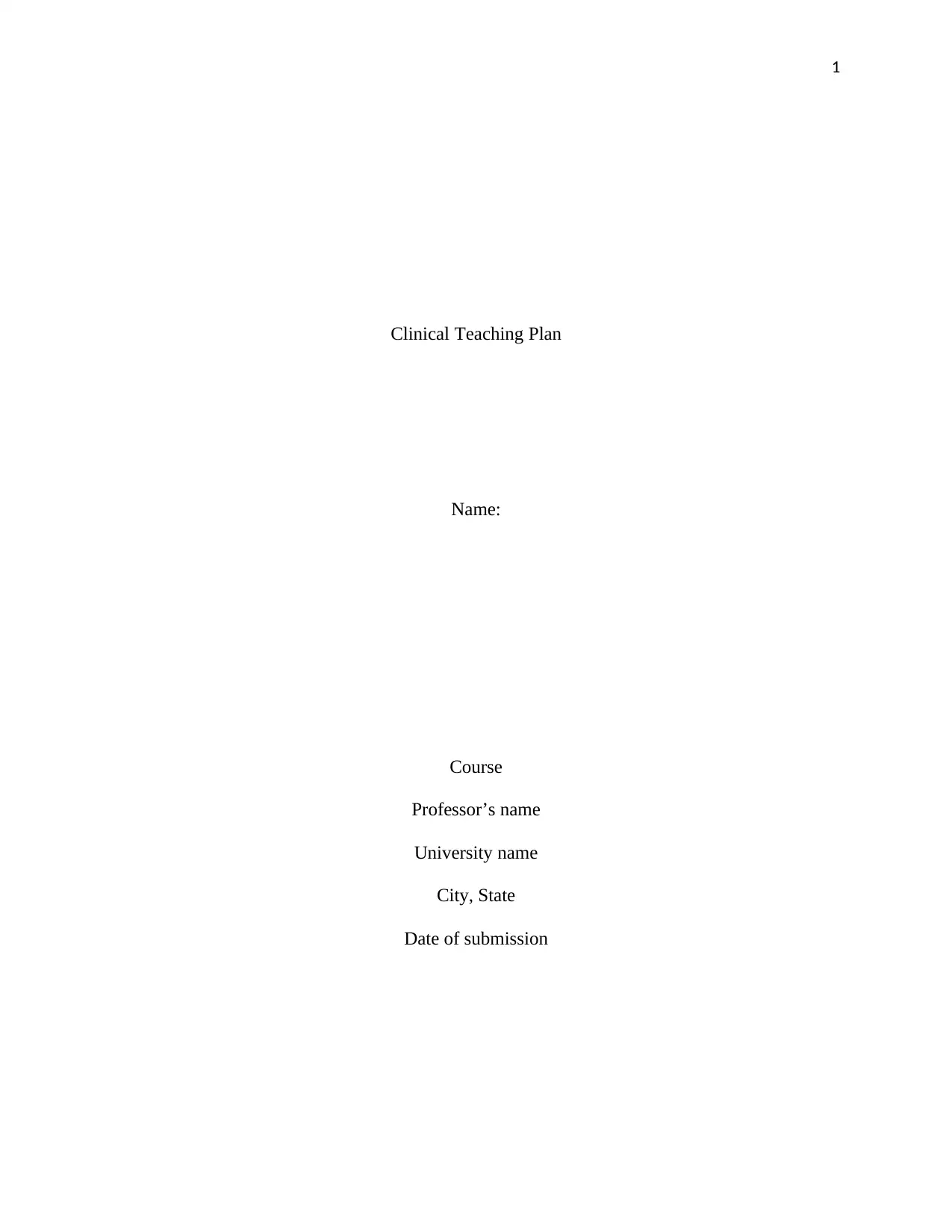
1
Clinical Teaching Plan
Name:
Course
Professor’s name
University name
City, State
Date of submission
Clinical Teaching Plan
Name:
Course
Professor’s name
University name
City, State
Date of submission
Paraphrase This Document
Need a fresh take? Get an instant paraphrase of this document with our AI Paraphraser
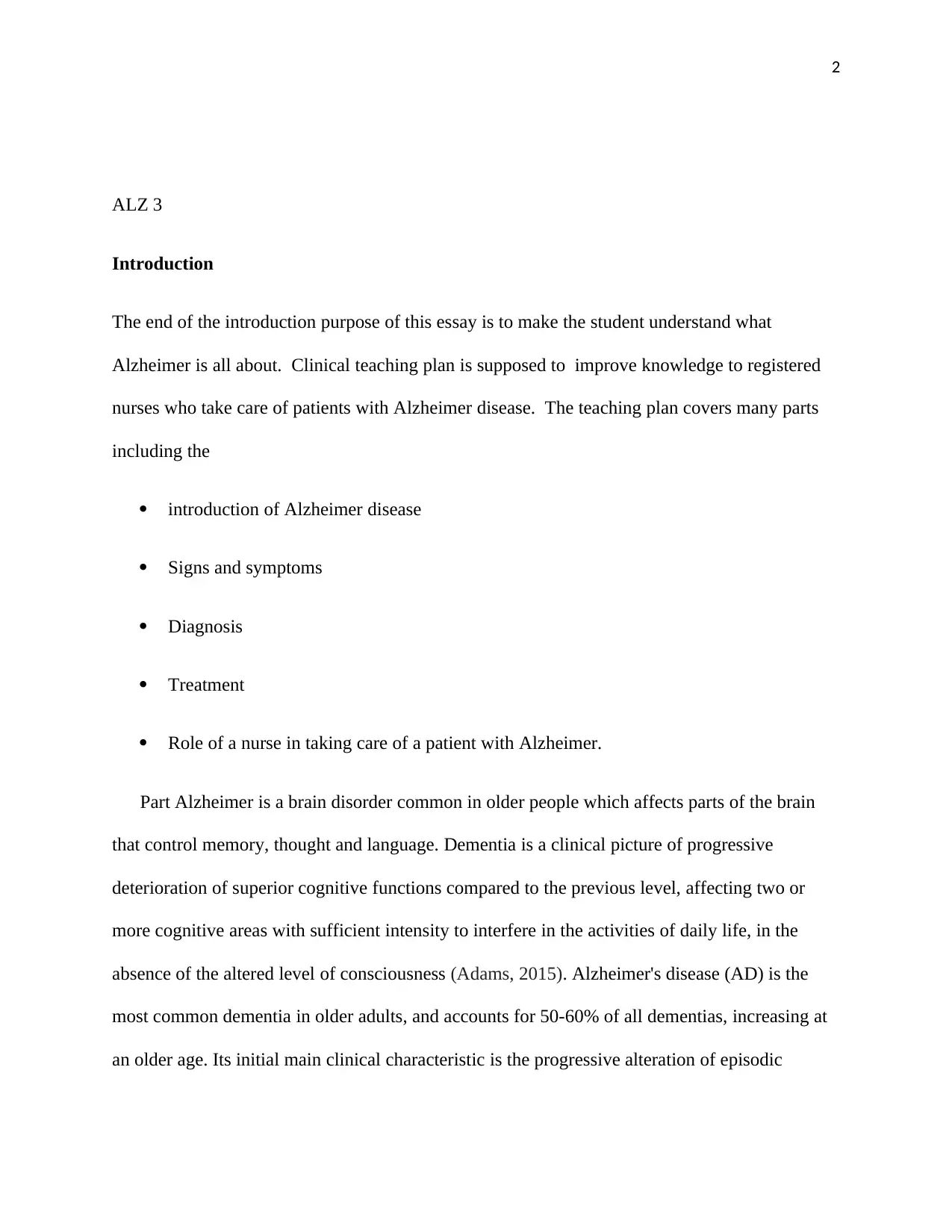
2
ALZ 3
Introduction
The end of the introduction purpose of this essay is to make the student understand what
Alzheimer is all about. Clinical teaching plan is supposed to improve knowledge to registered
nurses who take care of patients with Alzheimer disease. The teaching plan covers many parts
including the
introduction of Alzheimer disease
Signs and symptoms
Diagnosis
Treatment
Role of a nurse in taking care of a patient with Alzheimer.
Part Alzheimer is a brain disorder common in older people which affects parts of the brain
that control memory, thought and language. Dementia is a clinical picture of progressive
deterioration of superior cognitive functions compared to the previous level, affecting two or
more cognitive areas with sufficient intensity to interfere in the activities of daily life, in the
absence of the altered level of consciousness (Adams, 2015). Alzheimer's disease (AD) is the
most common dementia in older adults, and accounts for 50-60% of all dementias, increasing at
an older age. Its initial main clinical characteristic is the progressive alteration of episodic
ALZ 3
Introduction
The end of the introduction purpose of this essay is to make the student understand what
Alzheimer is all about. Clinical teaching plan is supposed to improve knowledge to registered
nurses who take care of patients with Alzheimer disease. The teaching plan covers many parts
including the
introduction of Alzheimer disease
Signs and symptoms
Diagnosis
Treatment
Role of a nurse in taking care of a patient with Alzheimer.
Part Alzheimer is a brain disorder common in older people which affects parts of the brain
that control memory, thought and language. Dementia is a clinical picture of progressive
deterioration of superior cognitive functions compared to the previous level, affecting two or
more cognitive areas with sufficient intensity to interfere in the activities of daily life, in the
absence of the altered level of consciousness (Adams, 2015). Alzheimer's disease (AD) is the
most common dementia in older adults, and accounts for 50-60% of all dementias, increasing at
an older age. Its initial main clinical characteristic is the progressive alteration of episodic
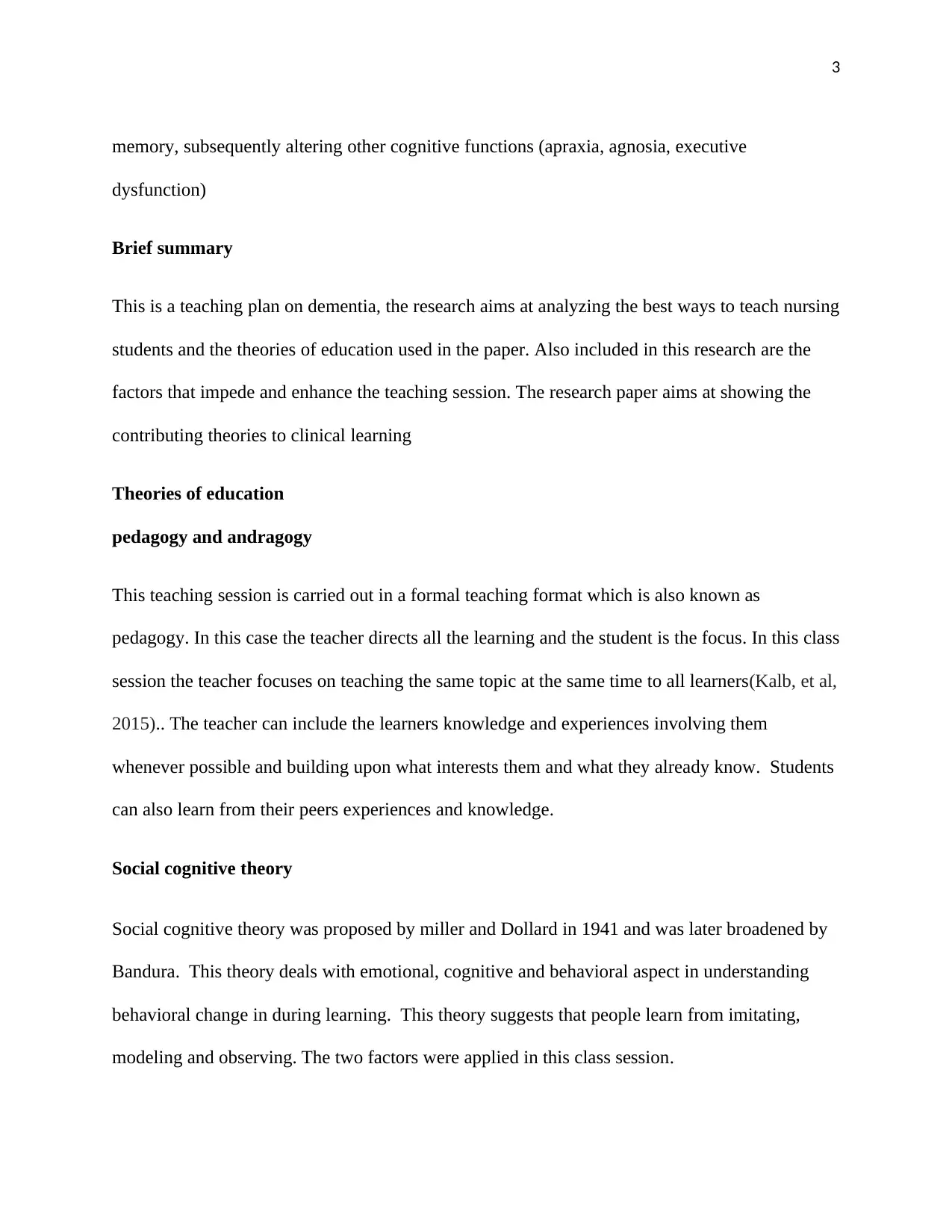
3
memory, subsequently altering other cognitive functions (apraxia, agnosia, executive
dysfunction)
Brief summary
This is a teaching plan on dementia, the research aims at analyzing the best ways to teach nursing
students and the theories of education used in the paper. Also included in this research are the
factors that impede and enhance the teaching session. The research paper aims at showing the
contributing theories to clinical learning
Theories of education
pedagogy and andragogy
This teaching session is carried out in a formal teaching format which is also known as
pedagogy. In this case the teacher directs all the learning and the student is the focus. In this class
session the teacher focuses on teaching the same topic at the same time to all learners(Kalb, et al,
2015).. The teacher can include the learners knowledge and experiences involving them
whenever possible and building upon what interests them and what they already know. Students
can also learn from their peers experiences and knowledge.
Social cognitive theory
Social cognitive theory was proposed by miller and Dollard in 1941 and was later broadened by
Bandura. This theory deals with emotional, cognitive and behavioral aspect in understanding
behavioral change in during learning. This theory suggests that people learn from imitating,
modeling and observing. The two factors were applied in this class session.
memory, subsequently altering other cognitive functions (apraxia, agnosia, executive
dysfunction)
Brief summary
This is a teaching plan on dementia, the research aims at analyzing the best ways to teach nursing
students and the theories of education used in the paper. Also included in this research are the
factors that impede and enhance the teaching session. The research paper aims at showing the
contributing theories to clinical learning
Theories of education
pedagogy and andragogy
This teaching session is carried out in a formal teaching format which is also known as
pedagogy. In this case the teacher directs all the learning and the student is the focus. In this class
session the teacher focuses on teaching the same topic at the same time to all learners(Kalb, et al,
2015).. The teacher can include the learners knowledge and experiences involving them
whenever possible and building upon what interests them and what they already know. Students
can also learn from their peers experiences and knowledge.
Social cognitive theory
Social cognitive theory was proposed by miller and Dollard in 1941 and was later broadened by
Bandura. This theory deals with emotional, cognitive and behavioral aspect in understanding
behavioral change in during learning. This theory suggests that people learn from imitating,
modeling and observing. The two factors were applied in this class session.
⊘ This is a preview!⊘
Do you want full access?
Subscribe today to unlock all pages.

Trusted by 1+ million students worldwide
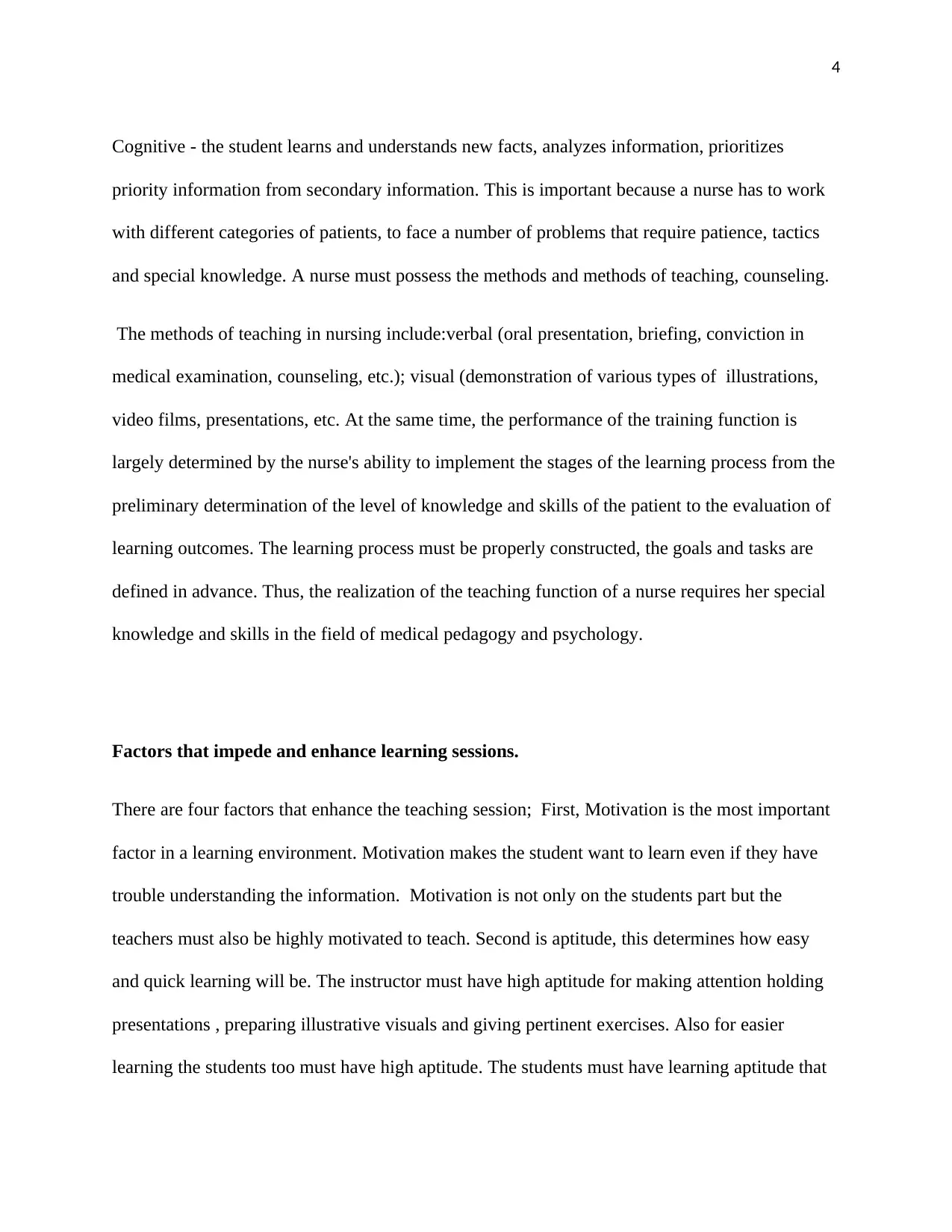
4
Cognitive - the student learns and understands new facts, analyzes information, prioritizes
priority information from secondary information. This is important because a nurse has to work
with different categories of patients, to face a number of problems that require patience, tactics
and special knowledge. A nurse must possess the methods and methods of teaching, counseling.
The methods of teaching in nursing include:verbal (oral presentation, briefing, conviction in
medical examination, counseling, etc.); visual (demonstration of various types of illustrations,
video films, presentations, etc. At the same time, the performance of the training function is
largely determined by the nurse's ability to implement the stages of the learning process from the
preliminary determination of the level of knowledge and skills of the patient to the evaluation of
learning outcomes. The learning process must be properly constructed, the goals and tasks are
defined in advance. Thus, the realization of the teaching function of a nurse requires her special
knowledge and skills in the field of medical pedagogy and psychology.
Factors that impede and enhance learning sessions.
There are four factors that enhance the teaching session; First, Motivation is the most important
factor in a learning environment. Motivation makes the student want to learn even if they have
trouble understanding the information. Motivation is not only on the students part but the
teachers must also be highly motivated to teach. Second is aptitude, this determines how easy
and quick learning will be. The instructor must have high aptitude for making attention holding
presentations , preparing illustrative visuals and giving pertinent exercises. Also for easier
learning the students too must have high aptitude. The students must have learning aptitude that
Cognitive - the student learns and understands new facts, analyzes information, prioritizes
priority information from secondary information. This is important because a nurse has to work
with different categories of patients, to face a number of problems that require patience, tactics
and special knowledge. A nurse must possess the methods and methods of teaching, counseling.
The methods of teaching in nursing include:verbal (oral presentation, briefing, conviction in
medical examination, counseling, etc.); visual (demonstration of various types of illustrations,
video films, presentations, etc. At the same time, the performance of the training function is
largely determined by the nurse's ability to implement the stages of the learning process from the
preliminary determination of the level of knowledge and skills of the patient to the evaluation of
learning outcomes. The learning process must be properly constructed, the goals and tasks are
defined in advance. Thus, the realization of the teaching function of a nurse requires her special
knowledge and skills in the field of medical pedagogy and psychology.
Factors that impede and enhance learning sessions.
There are four factors that enhance the teaching session; First, Motivation is the most important
factor in a learning environment. Motivation makes the student want to learn even if they have
trouble understanding the information. Motivation is not only on the students part but the
teachers must also be highly motivated to teach. Second is aptitude, this determines how easy
and quick learning will be. The instructor must have high aptitude for making attention holding
presentations , preparing illustrative visuals and giving pertinent exercises. Also for easier
learning the students too must have high aptitude. The students must have learning aptitude that
Paraphrase This Document
Need a fresh take? Get an instant paraphrase of this document with our AI Paraphraser
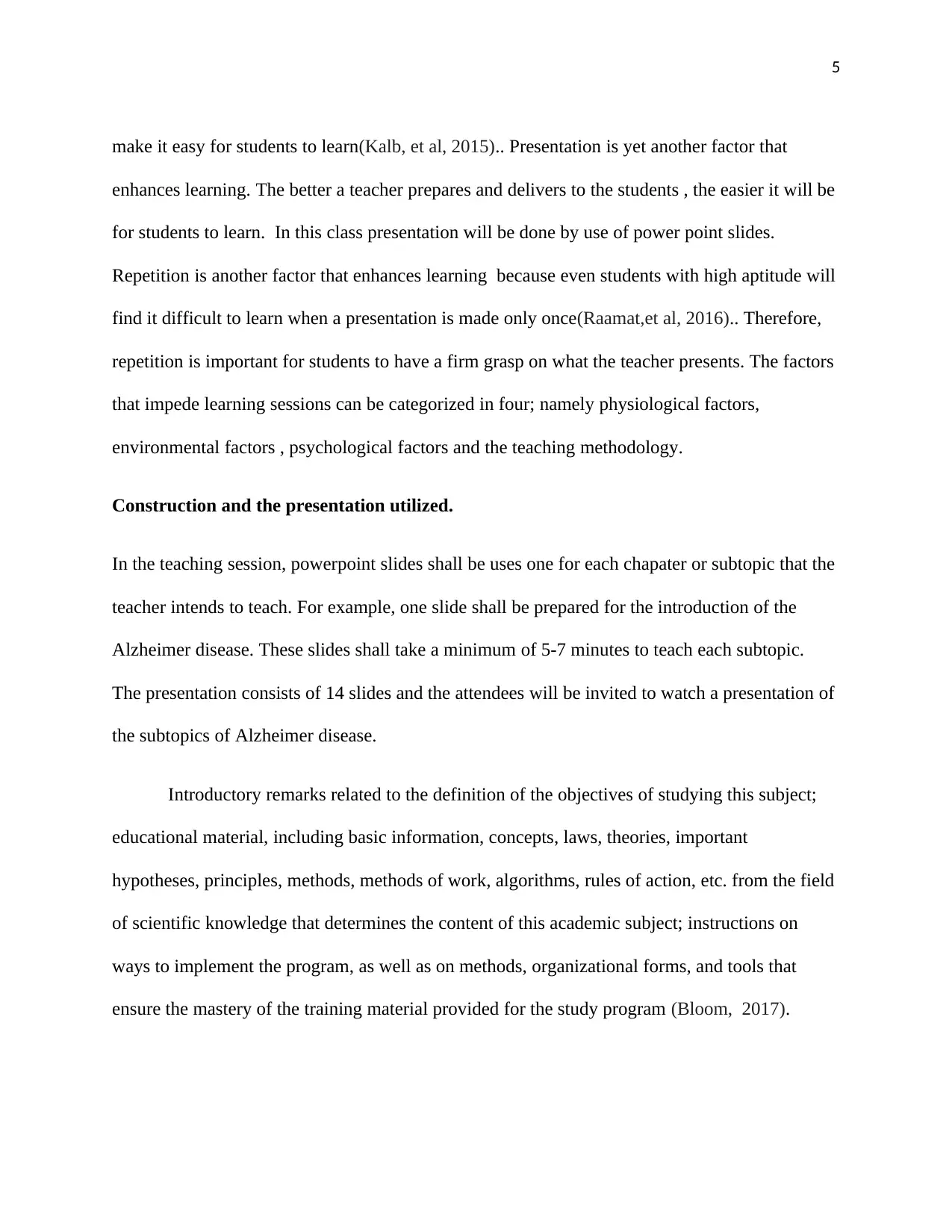
5
make it easy for students to learn(Kalb, et al, 2015).. Presentation is yet another factor that
enhances learning. The better a teacher prepares and delivers to the students , the easier it will be
for students to learn. In this class presentation will be done by use of power point slides.
Repetition is another factor that enhances learning because even students with high aptitude will
find it difficult to learn when a presentation is made only once(Raamat,et al, 2016).. Therefore,
repetition is important for students to have a firm grasp on what the teacher presents. The factors
that impede learning sessions can be categorized in four; namely physiological factors,
environmental factors , psychological factors and the teaching methodology.
Construction and the presentation utilized.
In the teaching session, powerpoint slides shall be uses one for each chapater or subtopic that the
teacher intends to teach. For example, one slide shall be prepared for the introduction of the
Alzheimer disease. These slides shall take a minimum of 5-7 minutes to teach each subtopic.
The presentation consists of 14 slides and the attendees will be invited to watch a presentation of
the subtopics of Alzheimer disease.
Introductory remarks related to the definition of the objectives of studying this subject;
educational material, including basic information, concepts, laws, theories, important
hypotheses, principles, methods, methods of work, algorithms, rules of action, etc. from the field
of scientific knowledge that determines the content of this academic subject; instructions on
ways to implement the program, as well as on methods, organizational forms, and tools that
ensure the mastery of the training material provided for the study program (Bloom, 2017).
make it easy for students to learn(Kalb, et al, 2015).. Presentation is yet another factor that
enhances learning. The better a teacher prepares and delivers to the students , the easier it will be
for students to learn. In this class presentation will be done by use of power point slides.
Repetition is another factor that enhances learning because even students with high aptitude will
find it difficult to learn when a presentation is made only once(Raamat,et al, 2016).. Therefore,
repetition is important for students to have a firm grasp on what the teacher presents. The factors
that impede learning sessions can be categorized in four; namely physiological factors,
environmental factors , psychological factors and the teaching methodology.
Construction and the presentation utilized.
In the teaching session, powerpoint slides shall be uses one for each chapater or subtopic that the
teacher intends to teach. For example, one slide shall be prepared for the introduction of the
Alzheimer disease. These slides shall take a minimum of 5-7 minutes to teach each subtopic.
The presentation consists of 14 slides and the attendees will be invited to watch a presentation of
the subtopics of Alzheimer disease.
Introductory remarks related to the definition of the objectives of studying this subject;
educational material, including basic information, concepts, laws, theories, important
hypotheses, principles, methods, methods of work, algorithms, rules of action, etc. from the field
of scientific knowledge that determines the content of this academic subject; instructions on
ways to implement the program, as well as on methods, organizational forms, and tools that
ensure the mastery of the training material provided for the study program (Bloom, 2017).
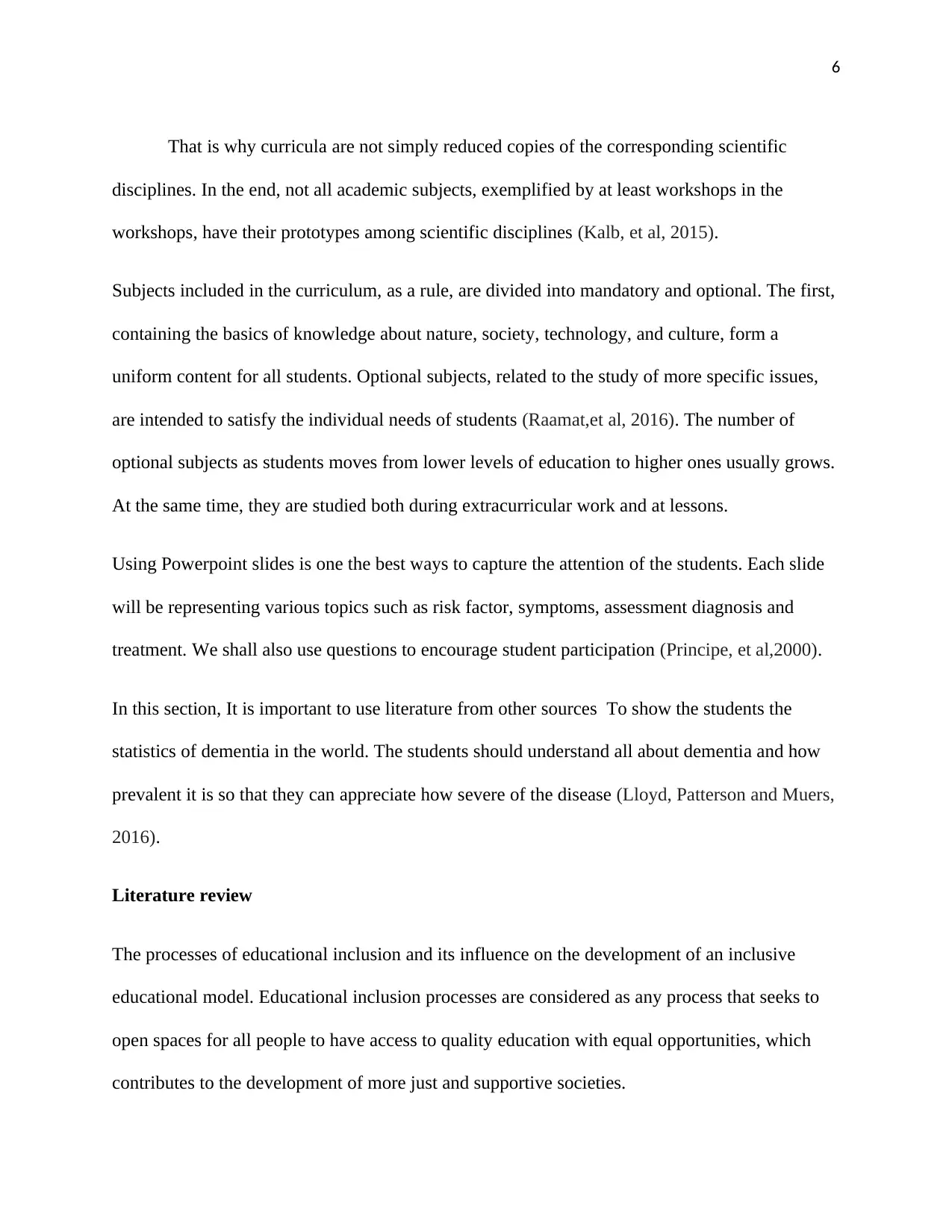
6
That is why curricula are not simply reduced copies of the corresponding scientific
disciplines. In the end, not all academic subjects, exemplified by at least workshops in the
workshops, have their prototypes among scientific disciplines (Kalb, et al, 2015).
Subjects included in the curriculum, as a rule, are divided into mandatory and optional. The first,
containing the basics of knowledge about nature, society, technology, and culture, form a
uniform content for all students. Optional subjects, related to the study of more specific issues,
are intended to satisfy the individual needs of students (Raamat,et al, 2016). The number of
optional subjects as students moves from lower levels of education to higher ones usually grows.
At the same time, they are studied both during extracurricular work and at lessons.
Using Powerpoint slides is one the best ways to capture the attention of the students. Each slide
will be representing various topics such as risk factor, symptoms, assessment diagnosis and
treatment. We shall also use questions to encourage student participation (Principe, et al,2000).
In this section, It is important to use literature from other sources To show the students the
statistics of dementia in the world. The students should understand all about dementia and how
prevalent it is so that they can appreciate how severe of the disease (Lloyd, Patterson and Muers,
2016).
Literature review
The processes of educational inclusion and its influence on the development of an inclusive
educational model. Educational inclusion processes are considered as any process that seeks to
open spaces for all people to have access to quality education with equal opportunities, which
contributes to the development of more just and supportive societies.
That is why curricula are not simply reduced copies of the corresponding scientific
disciplines. In the end, not all academic subjects, exemplified by at least workshops in the
workshops, have their prototypes among scientific disciplines (Kalb, et al, 2015).
Subjects included in the curriculum, as a rule, are divided into mandatory and optional. The first,
containing the basics of knowledge about nature, society, technology, and culture, form a
uniform content for all students. Optional subjects, related to the study of more specific issues,
are intended to satisfy the individual needs of students (Raamat,et al, 2016). The number of
optional subjects as students moves from lower levels of education to higher ones usually grows.
At the same time, they are studied both during extracurricular work and at lessons.
Using Powerpoint slides is one the best ways to capture the attention of the students. Each slide
will be representing various topics such as risk factor, symptoms, assessment diagnosis and
treatment. We shall also use questions to encourage student participation (Principe, et al,2000).
In this section, It is important to use literature from other sources To show the students the
statistics of dementia in the world. The students should understand all about dementia and how
prevalent it is so that they can appreciate how severe of the disease (Lloyd, Patterson and Muers,
2016).
Literature review
The processes of educational inclusion and its influence on the development of an inclusive
educational model. Educational inclusion processes are considered as any process that seeks to
open spaces for all people to have access to quality education with equal opportunities, which
contributes to the development of more just and supportive societies.
⊘ This is a preview!⊘
Do you want full access?
Subscribe today to unlock all pages.

Trusted by 1+ million students worldwide
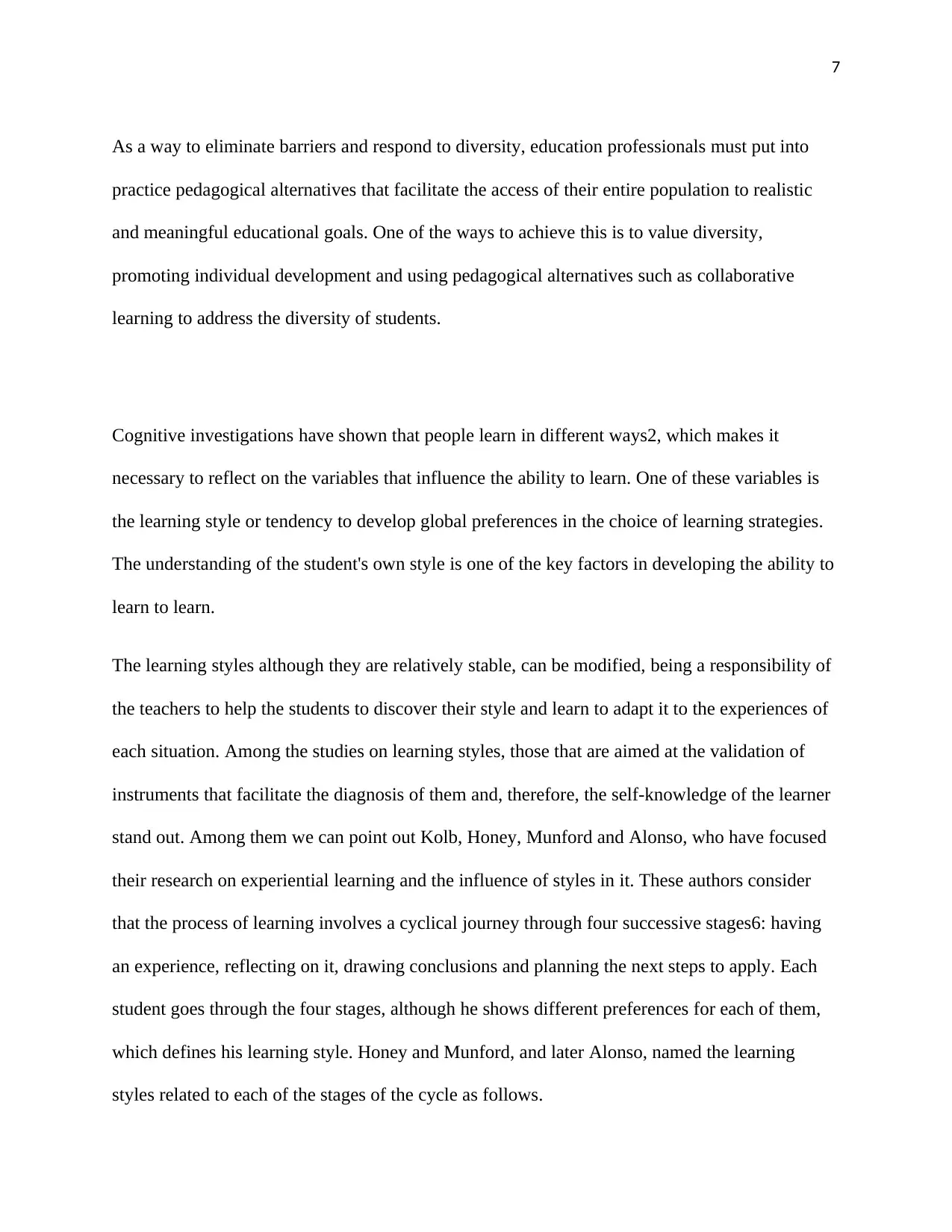
7
As a way to eliminate barriers and respond to diversity, education professionals must put into
practice pedagogical alternatives that facilitate the access of their entire population to realistic
and meaningful educational goals. One of the ways to achieve this is to value diversity,
promoting individual development and using pedagogical alternatives such as collaborative
learning to address the diversity of students.
Cognitive investigations have shown that people learn in different ways2, which makes it
necessary to reflect on the variables that influence the ability to learn. One of these variables is
the learning style or tendency to develop global preferences in the choice of learning strategies.
The understanding of the student's own style is one of the key factors in developing the ability to
learn to learn.
The learning styles although they are relatively stable, can be modified, being a responsibility of
the teachers to help the students to discover their style and learn to adapt it to the experiences of
each situation. Among the studies on learning styles, those that are aimed at the validation of
instruments that facilitate the diagnosis of them and, therefore, the self-knowledge of the learner
stand out. Among them we can point out Kolb, Honey, Munford and Alonso, who have focused
their research on experiential learning and the influence of styles in it. These authors consider
that the process of learning involves a cyclical journey through four successive stages6: having
an experience, reflecting on it, drawing conclusions and planning the next steps to apply. Each
student goes through the four stages, although he shows different preferences for each of them,
which defines his learning style. Honey and Munford, and later Alonso, named the learning
styles related to each of the stages of the cycle as follows.
As a way to eliminate barriers and respond to diversity, education professionals must put into
practice pedagogical alternatives that facilitate the access of their entire population to realistic
and meaningful educational goals. One of the ways to achieve this is to value diversity,
promoting individual development and using pedagogical alternatives such as collaborative
learning to address the diversity of students.
Cognitive investigations have shown that people learn in different ways2, which makes it
necessary to reflect on the variables that influence the ability to learn. One of these variables is
the learning style or tendency to develop global preferences in the choice of learning strategies.
The understanding of the student's own style is one of the key factors in developing the ability to
learn to learn.
The learning styles although they are relatively stable, can be modified, being a responsibility of
the teachers to help the students to discover their style and learn to adapt it to the experiences of
each situation. Among the studies on learning styles, those that are aimed at the validation of
instruments that facilitate the diagnosis of them and, therefore, the self-knowledge of the learner
stand out. Among them we can point out Kolb, Honey, Munford and Alonso, who have focused
their research on experiential learning and the influence of styles in it. These authors consider
that the process of learning involves a cyclical journey through four successive stages6: having
an experience, reflecting on it, drawing conclusions and planning the next steps to apply. Each
student goes through the four stages, although he shows different preferences for each of them,
which defines his learning style. Honey and Munford, and later Alonso, named the learning
styles related to each of the stages of the cycle as follows.
Paraphrase This Document
Need a fresh take? Get an instant paraphrase of this document with our AI Paraphraser
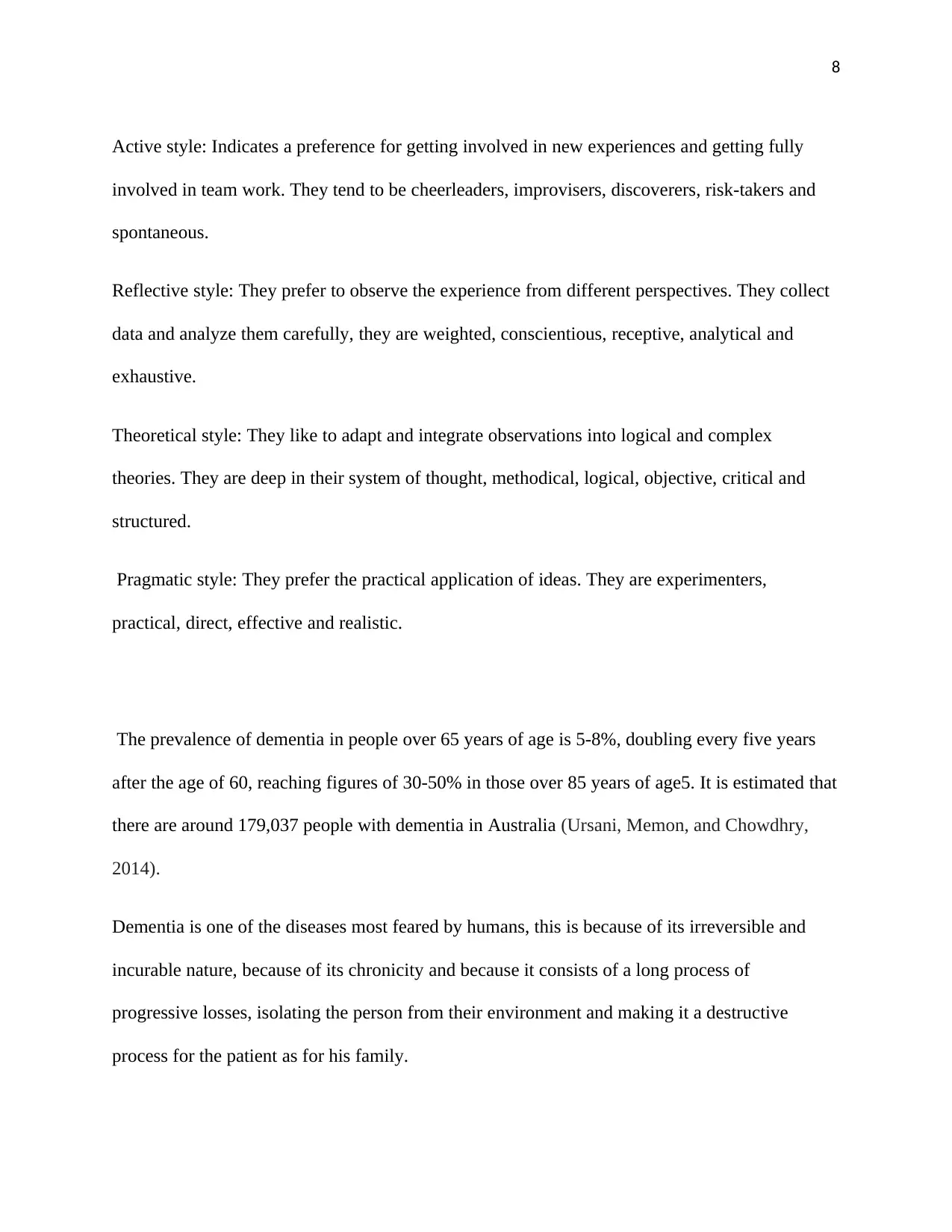
8
Active style: Indicates a preference for getting involved in new experiences and getting fully
involved in team work. They tend to be cheerleaders, improvisers, discoverers, risk-takers and
spontaneous.
Reflective style: They prefer to observe the experience from different perspectives. They collect
data and analyze them carefully, they are weighted, conscientious, receptive, analytical and
exhaustive.
Theoretical style: They like to adapt and integrate observations into logical and complex
theories. They are deep in their system of thought, methodical, logical, objective, critical and
structured.
Pragmatic style: They prefer the practical application of ideas. They are experimenters,
practical, direct, effective and realistic.
The prevalence of dementia in people over 65 years of age is 5-8%, doubling every five years
after the age of 60, reaching figures of 30-50% in those over 85 years of age5. It is estimated that
there are around 179,037 people with dementia in Australia (Ursani, Memon, and Chowdhry,
2014).
Dementia is one of the diseases most feared by humans, this is because of its irreversible and
incurable nature, because of its chronicity and because it consists of a long process of
progressive losses, isolating the person from their environment and making it a destructive
process for the patient as for his family.
Active style: Indicates a preference for getting involved in new experiences and getting fully
involved in team work. They tend to be cheerleaders, improvisers, discoverers, risk-takers and
spontaneous.
Reflective style: They prefer to observe the experience from different perspectives. They collect
data and analyze them carefully, they are weighted, conscientious, receptive, analytical and
exhaustive.
Theoretical style: They like to adapt and integrate observations into logical and complex
theories. They are deep in their system of thought, methodical, logical, objective, critical and
structured.
Pragmatic style: They prefer the practical application of ideas. They are experimenters,
practical, direct, effective and realistic.
The prevalence of dementia in people over 65 years of age is 5-8%, doubling every five years
after the age of 60, reaching figures of 30-50% in those over 85 years of age5. It is estimated that
there are around 179,037 people with dementia in Australia (Ursani, Memon, and Chowdhry,
2014).
Dementia is one of the diseases most feared by humans, this is because of its irreversible and
incurable nature, because of its chronicity and because it consists of a long process of
progressive losses, isolating the person from their environment and making it a destructive
process for the patient as for his family.
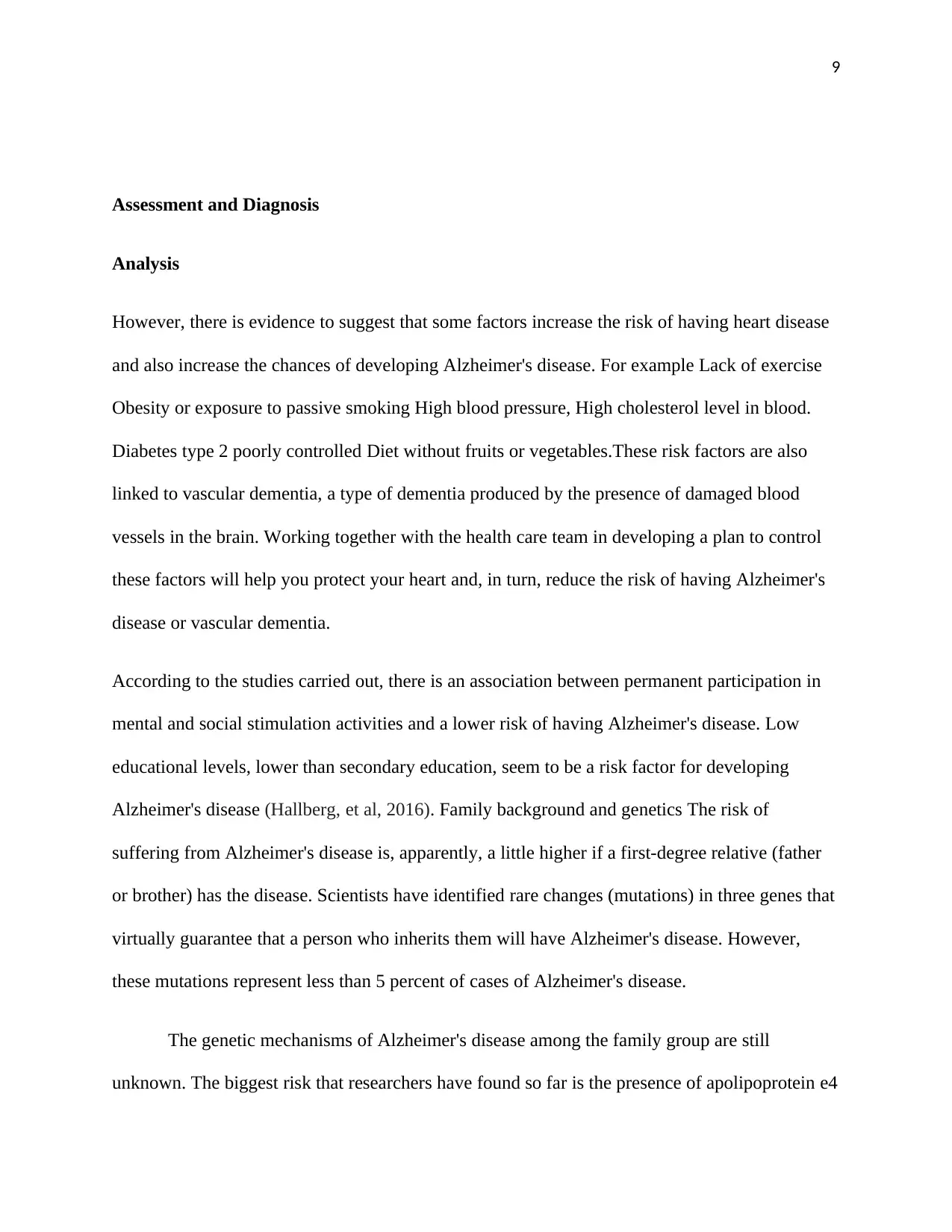
9
Assessment and Diagnosis
Analysis
However, there is evidence to suggest that some factors increase the risk of having heart disease
and also increase the chances of developing Alzheimer's disease. For example Lack of exercise
Obesity or exposure to passive smoking High blood pressure, High cholesterol level in blood.
Diabetes type 2 poorly controlled Diet without fruits or vegetables.These risk factors are also
linked to vascular dementia, a type of dementia produced by the presence of damaged blood
vessels in the brain. Working together with the health care team in developing a plan to control
these factors will help you protect your heart and, in turn, reduce the risk of having Alzheimer's
disease or vascular dementia.
According to the studies carried out, there is an association between permanent participation in
mental and social stimulation activities and a lower risk of having Alzheimer's disease. Low
educational levels, lower than secondary education, seem to be a risk factor for developing
Alzheimer's disease (Hallberg, et al, 2016). Family background and genetics The risk of
suffering from Alzheimer's disease is, apparently, a little higher if a first-degree relative (father
or brother) has the disease. Scientists have identified rare changes (mutations) in three genes that
virtually guarantee that a person who inherits them will have Alzheimer's disease. However,
these mutations represent less than 5 percent of cases of Alzheimer's disease.
The genetic mechanisms of Alzheimer's disease among the family group are still
unknown. The biggest risk that researchers have found so far is the presence of apolipoprotein e4
Assessment and Diagnosis
Analysis
However, there is evidence to suggest that some factors increase the risk of having heart disease
and also increase the chances of developing Alzheimer's disease. For example Lack of exercise
Obesity or exposure to passive smoking High blood pressure, High cholesterol level in blood.
Diabetes type 2 poorly controlled Diet without fruits or vegetables.These risk factors are also
linked to vascular dementia, a type of dementia produced by the presence of damaged blood
vessels in the brain. Working together with the health care team in developing a plan to control
these factors will help you protect your heart and, in turn, reduce the risk of having Alzheimer's
disease or vascular dementia.
According to the studies carried out, there is an association between permanent participation in
mental and social stimulation activities and a lower risk of having Alzheimer's disease. Low
educational levels, lower than secondary education, seem to be a risk factor for developing
Alzheimer's disease (Hallberg, et al, 2016). Family background and genetics The risk of
suffering from Alzheimer's disease is, apparently, a little higher if a first-degree relative (father
or brother) has the disease. Scientists have identified rare changes (mutations) in three genes that
virtually guarantee that a person who inherits them will have Alzheimer's disease. However,
these mutations represent less than 5 percent of cases of Alzheimer's disease.
The genetic mechanisms of Alzheimer's disease among the family group are still
unknown. The biggest risk that researchers have found so far is the presence of apolipoprotein e4
⊘ This is a preview!⊘
Do you want full access?
Subscribe today to unlock all pages.

Trusted by 1+ million students worldwide
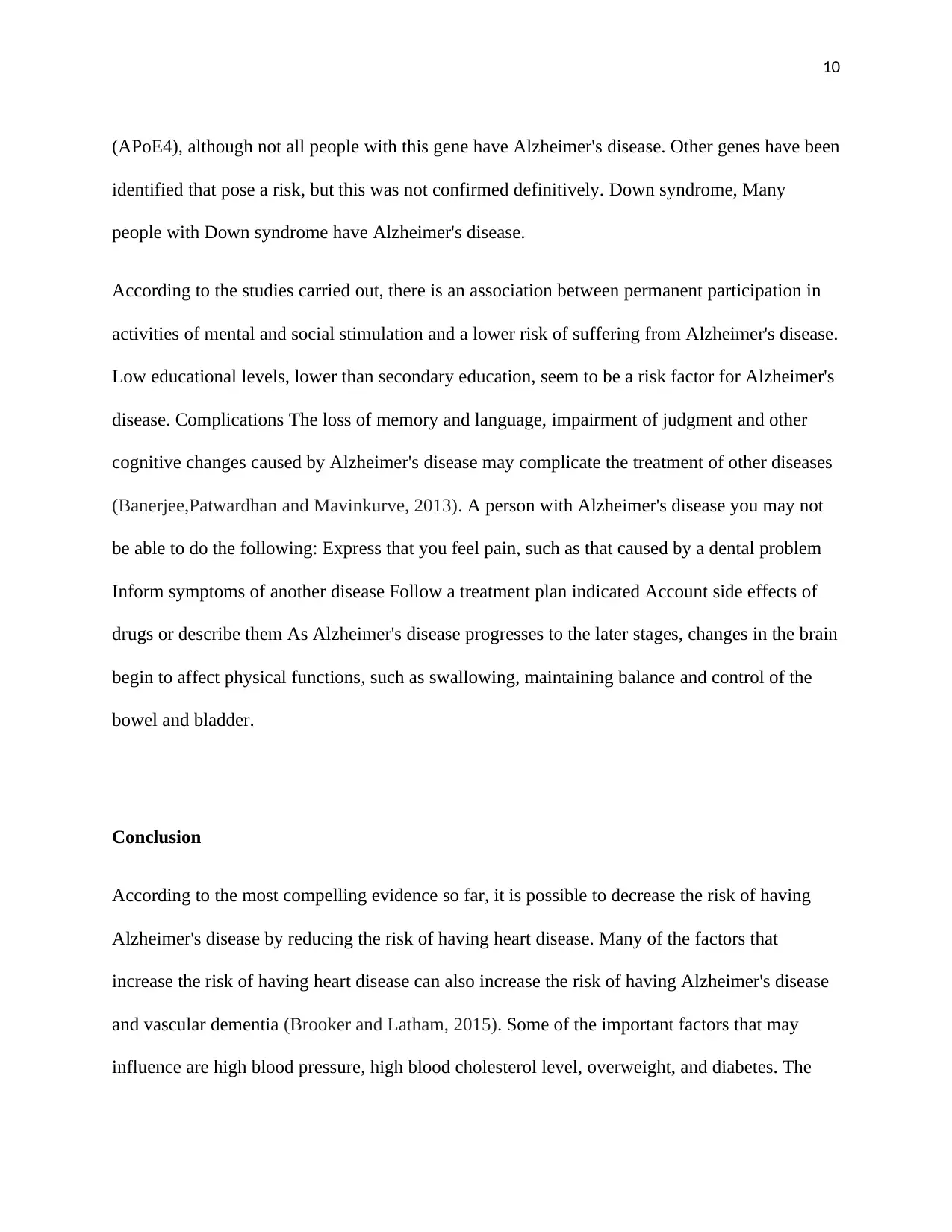
10
(APoE4), although not all people with this gene have Alzheimer's disease. Other genes have been
identified that pose a risk, but this was not confirmed definitively. Down syndrome, Many
people with Down syndrome have Alzheimer's disease.
According to the studies carried out, there is an association between permanent participation in
activities of mental and social stimulation and a lower risk of suffering from Alzheimer's disease.
Low educational levels, lower than secondary education, seem to be a risk factor for Alzheimer's
disease. Complications The loss of memory and language, impairment of judgment and other
cognitive changes caused by Alzheimer's disease may complicate the treatment of other diseases
(Banerjee,Patwardhan and Mavinkurve, 2013). A person with Alzheimer's disease you may not
be able to do the following: Express that you feel pain, such as that caused by a dental problem
Inform symptoms of another disease Follow a treatment plan indicated Account side effects of
drugs or describe them As Alzheimer's disease progresses to the later stages, changes in the brain
begin to affect physical functions, such as swallowing, maintaining balance and control of the
bowel and bladder.
Conclusion
According to the most compelling evidence so far, it is possible to decrease the risk of having
Alzheimer's disease by reducing the risk of having heart disease. Many of the factors that
increase the risk of having heart disease can also increase the risk of having Alzheimer's disease
and vascular dementia (Brooker and Latham, 2015). Some of the important factors that may
influence are high blood pressure, high blood cholesterol level, overweight, and diabetes. The
(APoE4), although not all people with this gene have Alzheimer's disease. Other genes have been
identified that pose a risk, but this was not confirmed definitively. Down syndrome, Many
people with Down syndrome have Alzheimer's disease.
According to the studies carried out, there is an association between permanent participation in
activities of mental and social stimulation and a lower risk of suffering from Alzheimer's disease.
Low educational levels, lower than secondary education, seem to be a risk factor for Alzheimer's
disease. Complications The loss of memory and language, impairment of judgment and other
cognitive changes caused by Alzheimer's disease may complicate the treatment of other diseases
(Banerjee,Patwardhan and Mavinkurve, 2013). A person with Alzheimer's disease you may not
be able to do the following: Express that you feel pain, such as that caused by a dental problem
Inform symptoms of another disease Follow a treatment plan indicated Account side effects of
drugs or describe them As Alzheimer's disease progresses to the later stages, changes in the brain
begin to affect physical functions, such as swallowing, maintaining balance and control of the
bowel and bladder.
Conclusion
According to the most compelling evidence so far, it is possible to decrease the risk of having
Alzheimer's disease by reducing the risk of having heart disease. Many of the factors that
increase the risk of having heart disease can also increase the risk of having Alzheimer's disease
and vascular dementia (Brooker and Latham, 2015). Some of the important factors that may
influence are high blood pressure, high blood cholesterol level, overweight, and diabetes. The
Paraphrase This Document
Need a fresh take? Get an instant paraphrase of this document with our AI Paraphraser
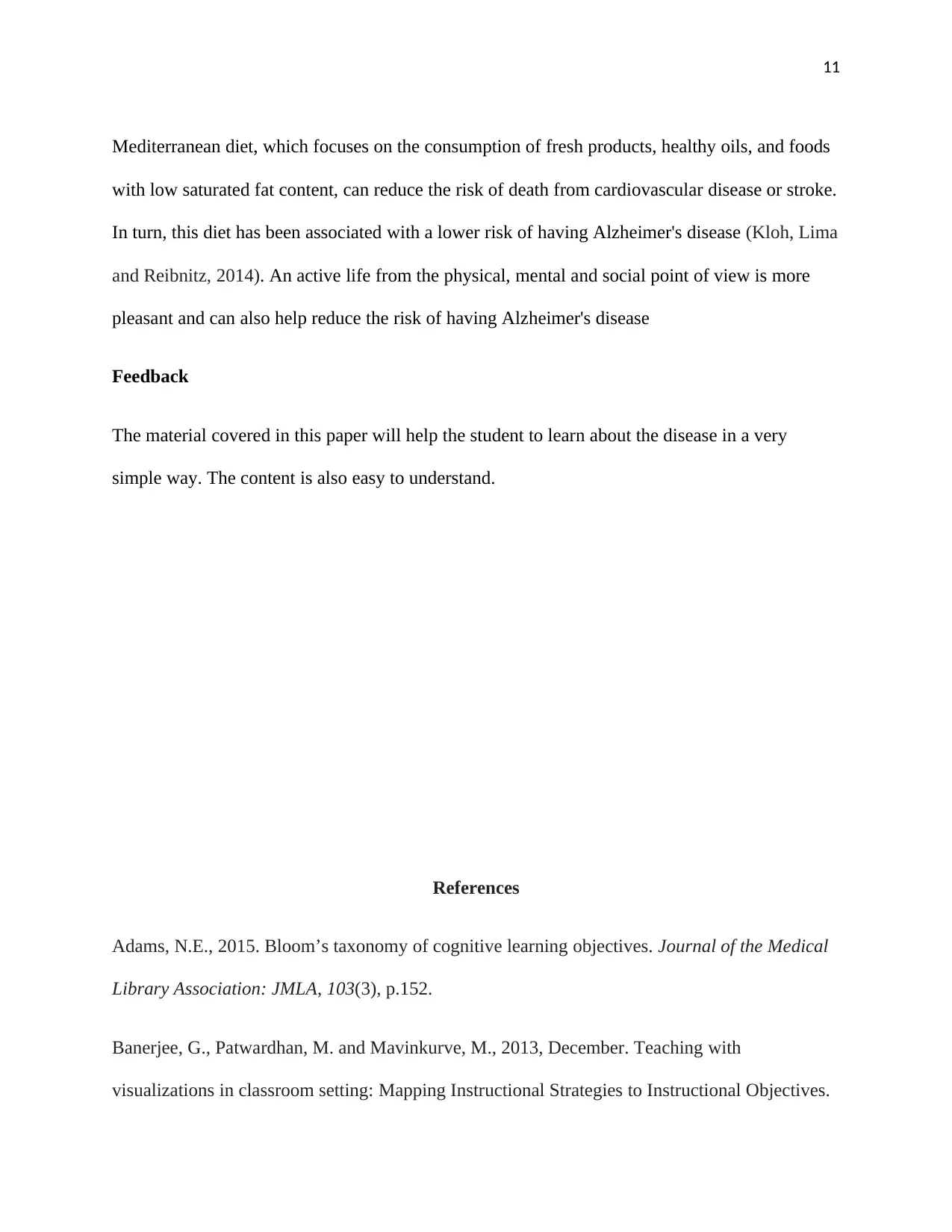
11
Mediterranean diet, which focuses on the consumption of fresh products, healthy oils, and foods
with low saturated fat content, can reduce the risk of death from cardiovascular disease or stroke.
In turn, this diet has been associated with a lower risk of having Alzheimer's disease (Kloh, Lima
and Reibnitz, 2014). An active life from the physical, mental and social point of view is more
pleasant and can also help reduce the risk of having Alzheimer's disease
Feedback
The material covered in this paper will help the student to learn about the disease in a very
simple way. The content is also easy to understand.
References
Adams, N.E., 2015. Bloom’s taxonomy of cognitive learning objectives. Journal of the Medical
Library Association: JMLA, 103(3), p.152.
Banerjee, G., Patwardhan, M. and Mavinkurve, M., 2013, December. Teaching with
visualizations in classroom setting: Mapping Instructional Strategies to Instructional Objectives.
Mediterranean diet, which focuses on the consumption of fresh products, healthy oils, and foods
with low saturated fat content, can reduce the risk of death from cardiovascular disease or stroke.
In turn, this diet has been associated with a lower risk of having Alzheimer's disease (Kloh, Lima
and Reibnitz, 2014). An active life from the physical, mental and social point of view is more
pleasant and can also help reduce the risk of having Alzheimer's disease
Feedback
The material covered in this paper will help the student to learn about the disease in a very
simple way. The content is also easy to understand.
References
Adams, N.E., 2015. Bloom’s taxonomy of cognitive learning objectives. Journal of the Medical
Library Association: JMLA, 103(3), p.152.
Banerjee, G., Patwardhan, M. and Mavinkurve, M., 2013, December. Teaching with
visualizations in classroom setting: Mapping Instructional Strategies to Instructional Objectives.
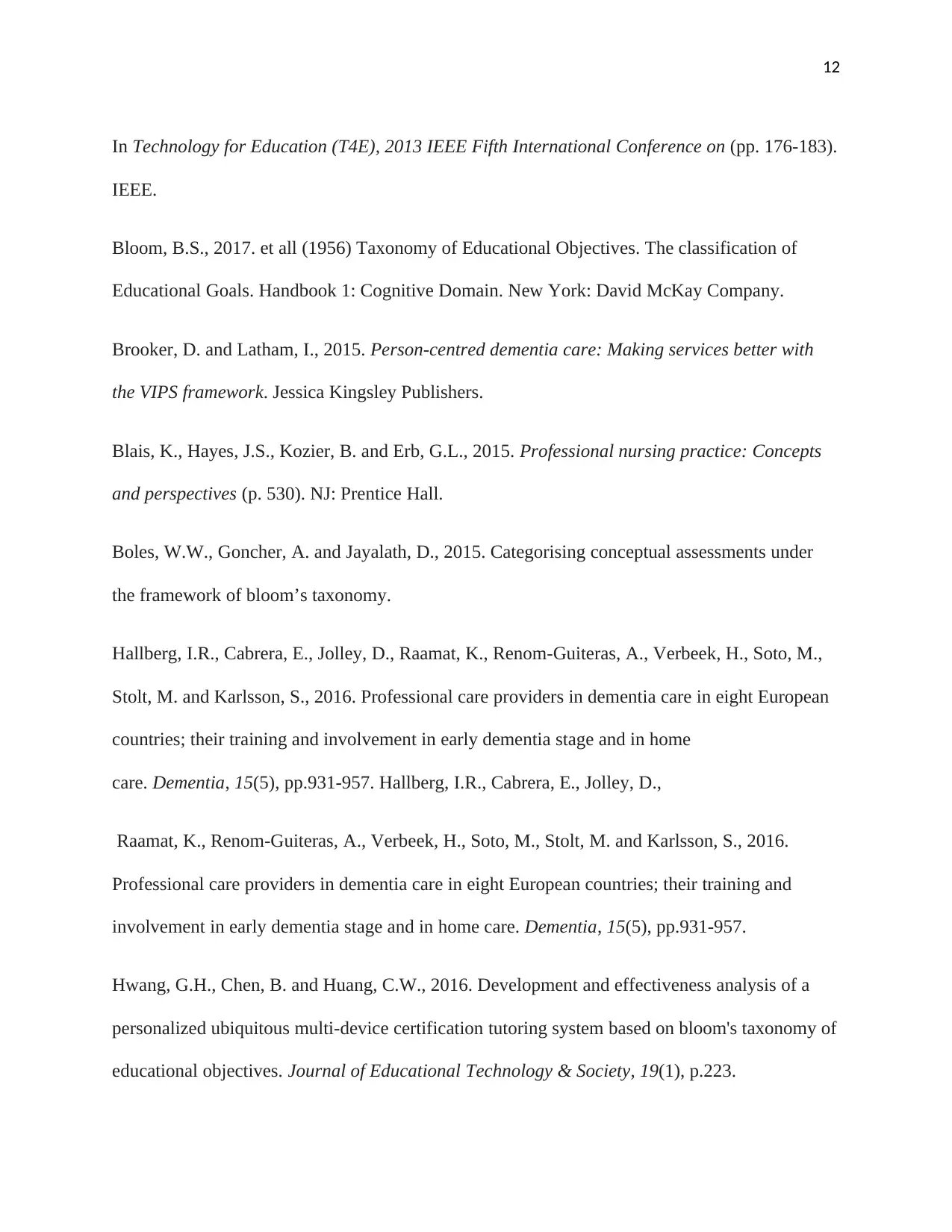
12
In Technology for Education (T4E), 2013 IEEE Fifth International Conference on (pp. 176-183).
IEEE.
Bloom, B.S., 2017. et all (1956) Taxonomy of Educational Objectives. The classification of
Educational Goals. Handbook 1: Cognitive Domain. New York: David McKay Company.
Brooker, D. and Latham, I., 2015. Person-centred dementia care: Making services better with
the VIPS framework. Jessica Kingsley Publishers.
Blais, K., Hayes, J.S., Kozier, B. and Erb, G.L., 2015. Professional nursing practice: Concepts
and perspectives (p. 530). NJ: Prentice Hall.
Boles, W.W., Goncher, A. and Jayalath, D., 2015. Categorising conceptual assessments under
the framework of bloom’s taxonomy.
Hallberg, I.R., Cabrera, E., Jolley, D., Raamat, K., Renom-Guiteras, A., Verbeek, H., Soto, M.,
Stolt, M. and Karlsson, S., 2016. Professional care providers in dementia care in eight European
countries; their training and involvement in early dementia stage and in home
care. Dementia, 15(5), pp.931-957. Hallberg, I.R., Cabrera, E., Jolley, D.,
Raamat, K., Renom-Guiteras, A., Verbeek, H., Soto, M., Stolt, M. and Karlsson, S., 2016.
Professional care providers in dementia care in eight European countries; their training and
involvement in early dementia stage and in home care. Dementia, 15(5), pp.931-957.
Hwang, G.H., Chen, B. and Huang, C.W., 2016. Development and effectiveness analysis of a
personalized ubiquitous multi-device certification tutoring system based on bloom's taxonomy of
educational objectives. Journal of Educational Technology & Society, 19(1), p.223.
In Technology for Education (T4E), 2013 IEEE Fifth International Conference on (pp. 176-183).
IEEE.
Bloom, B.S., 2017. et all (1956) Taxonomy of Educational Objectives. The classification of
Educational Goals. Handbook 1: Cognitive Domain. New York: David McKay Company.
Brooker, D. and Latham, I., 2015. Person-centred dementia care: Making services better with
the VIPS framework. Jessica Kingsley Publishers.
Blais, K., Hayes, J.S., Kozier, B. and Erb, G.L., 2015. Professional nursing practice: Concepts
and perspectives (p. 530). NJ: Prentice Hall.
Boles, W.W., Goncher, A. and Jayalath, D., 2015. Categorising conceptual assessments under
the framework of bloom’s taxonomy.
Hallberg, I.R., Cabrera, E., Jolley, D., Raamat, K., Renom-Guiteras, A., Verbeek, H., Soto, M.,
Stolt, M. and Karlsson, S., 2016. Professional care providers in dementia care in eight European
countries; their training and involvement in early dementia stage and in home
care. Dementia, 15(5), pp.931-957. Hallberg, I.R., Cabrera, E., Jolley, D.,
Raamat, K., Renom-Guiteras, A., Verbeek, H., Soto, M., Stolt, M. and Karlsson, S., 2016.
Professional care providers in dementia care in eight European countries; their training and
involvement in early dementia stage and in home care. Dementia, 15(5), pp.931-957.
Hwang, G.H., Chen, B. and Huang, C.W., 2016. Development and effectiveness analysis of a
personalized ubiquitous multi-device certification tutoring system based on bloom's taxonomy of
educational objectives. Journal of Educational Technology & Society, 19(1), p.223.
⊘ This is a preview!⊘
Do you want full access?
Subscribe today to unlock all pages.

Trusted by 1+ million students worldwide
1 out of 13
Related Documents
Your All-in-One AI-Powered Toolkit for Academic Success.
+13062052269
info@desklib.com
Available 24*7 on WhatsApp / Email
![[object Object]](/_next/static/media/star-bottom.7253800d.svg)
Unlock your academic potential
Copyright © 2020–2025 A2Z Services. All Rights Reserved. Developed and managed by ZUCOL.





